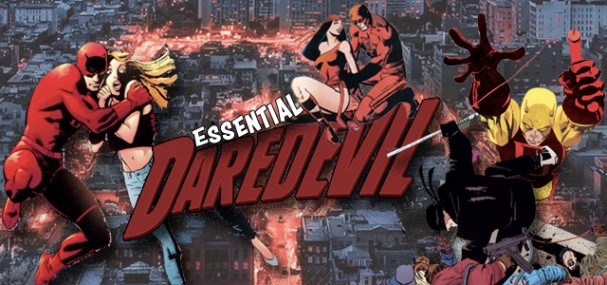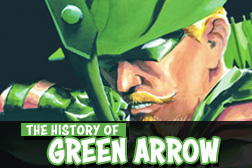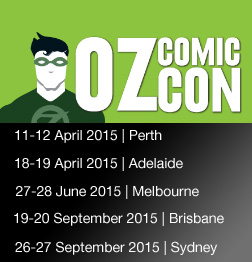Marvel’s DAREDEVIL for Netflix is set to bring the Man Without Fear back to life, the first live action depiction of the character since 2003’s film with Ben Affleck. The 13 episode series stars Charlie Cox in the titular role of Matt Murdock (aka Daredevil), and launches the TV universe that will include AKA Jessica Jones, Luke Cage, Iron Fist and The Defenders.
Daredevil has been graced with some of the best writers and artists that the industry has to offer over the years, yet consistently there are a handful of runs that keep demanding return visits to Hell’s Kitchen. Here’s a collection of books that not only inspired the series or its actors, but are damn fine pieces of comic bookery in their own right.
Agree or disagree? Got a comment? Start a conversation below, or take it with you on Behind the Panel’s Facebook and Twitter!
If you are an iTunes user, subscribe to our weekly podcast free here and please leave us feedback.
Frank Miller and the “Elektra Saga” (1981 – 1983)
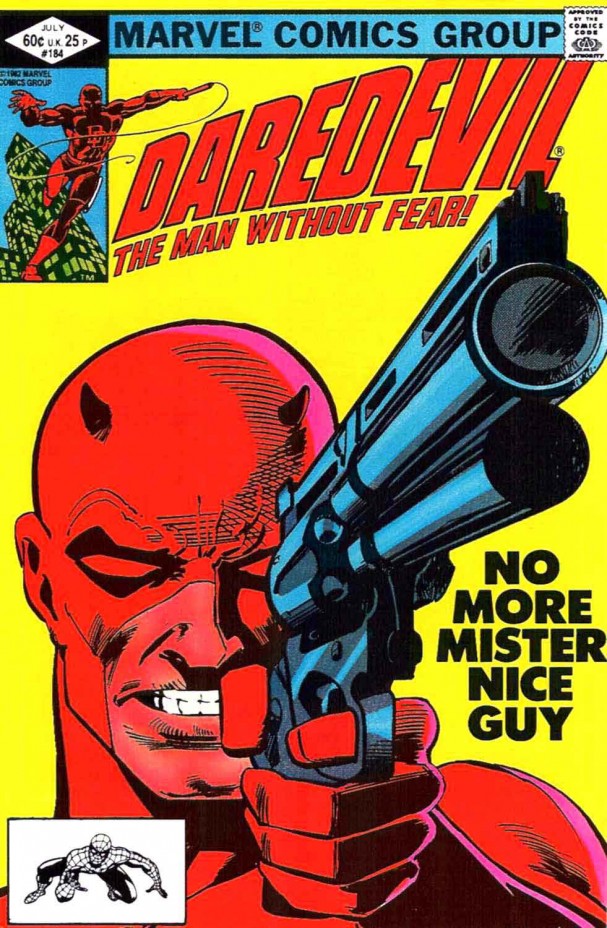 Frank Miller‘s name is going to come up a few times in this column, and for good reason. Since the mid 1970s, sales on DAREDEVIL had been declining steadily, but by the early 1980s the direct market sales were transforming the entire industry. At Marvel, relative newcomer Miller had acted as a fill-in and cover artist on titles such as Peter Parker, The Spectacular Spider-Man, until he was given the opportunity to pencil DAREDEVIL #158 for writer Roger McKenzie. The issue not only started an artistic collaboration with inker Klaus Janson, but commenced one of the most revered and influential runs in the character’s history.
Frank Miller‘s name is going to come up a few times in this column, and for good reason. Since the mid 1970s, sales on DAREDEVIL had been declining steadily, but by the early 1980s the direct market sales were transforming the entire industry. At Marvel, relative newcomer Miller had acted as a fill-in and cover artist on titles such as Peter Parker, The Spectacular Spider-Man, until he was given the opportunity to pencil DAREDEVIL #158 for writer Roger McKenzie. The issue not only started an artistic collaboration with inker Klaus Janson, but commenced one of the most revered and influential runs in the character’s history.
Miller soon began contributing plots, and eventually took over as writer. Over the course of his run that began with DAREDEVIL #168, Miller was instrumental in re-crafting the character (in Denny O’Neil’s words) “from a weak tea Spider-Man to a shooting star.” Introducing the character of the assassin Elektra – an equal, a lover, and a partner for Murdock – Miller played up the epic nature of the character, crafting something as massive as Chris Claremont’s X-Men within the confines of a previously pulpy title. Turning Spider-Man foil Kingpin into a formidable and powerful foe, Miller also crafted the potentially throwaway villain Bullseye into one of The Man Without Fear’s most deadly rogues.
Not simply an excellent story, Miller set the stage for the future of the Daredevil saga, putting pieces on the board that are still in the game over 30 years later. As Sean Howe notes in Marvel Comics: The Untold Story, “the debut of Frank Miller, auteur – was an instant hit. The whole industry finally sat up and took notice of the young Vermonter.” Fellow Daredevil scribe Brian Michael Bendis reflected on Miller’s run on the occasion of the character’s 75th anniversary in 2014: “Frank Miller is the most important thing. [His] Daredevil story is the greatest Daredevil story ever written.”
SEE ALSO: BEHIND THE PANELS Issue 11 – Daredevil Visionaries: Frank Miller Vol 2
Born Again (1986)
 As James Kelly notes at Sequart, “Miller’s seminal run on Daredevil alone was able to change the comics medium forever, but what makes Miller’s impact all the more resonant was that he would return to the character.” Following the departure of Denny O’Neill, Daredevil editor Ralph Macchio offered Frank Miller the chance to return to the character. Miller did so under the condition that artist David Mazzucchelli would work from full scripts.
As James Kelly notes at Sequart, “Miller’s seminal run on Daredevil alone was able to change the comics medium forever, but what makes Miller’s impact all the more resonant was that he would return to the character.” Following the departure of Denny O’Neill, Daredevil editor Ralph Macchio offered Frank Miller the chance to return to the character. Miller did so under the condition that artist David Mazzucchelli would work from full scripts.
If Daredevil is know for its Catholicism and religious references (something strongly revived by Kevin Smith in 1998’s Guardian Devil), then BORN AGAIN is the archetype for that thread. Macchio comments in his introduction to the collected edition, it’s Murdock who is the true hero of this piece. His alter ego exposed, the Kingpin begins to systematically pull Murdock apart, running him through the ringer and testing his faith. If the character of his mother as a nun nursing him back to health isn’t clear enough as an analogy to the Virgin Mary, then the visual cues to the stations of the cross and the crucifixion hammer home Miller’s meaning.
A triumph of both art and writing, Mazzucchelli’s art is best described by Miller: “He makes a three-dimensional stage of an individual panel, complete in authentic detail, nonetheless uncluttered and utterly readable. He creates actors whose dramatic range is startling, whose best and most compelling moments are wordless.” Regularly making “best of all-time” lists across the board, BORN AGAIN gets right to the heart of what Daredevil is as a character – and that is Matt Murdock.
The Man Without Fear (1993 – 1994)
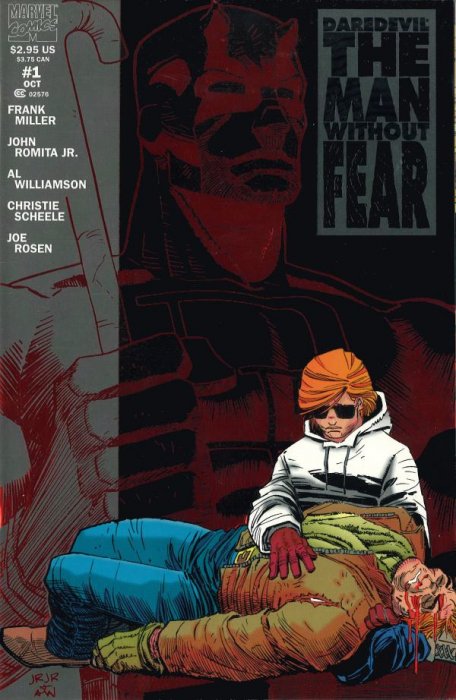 Miller’s next return to the character would be as a standalone mini-series, and this perhaps is set to be one of the single biggest influences on the new Netflix series. Miller’s return brought with it a retconned view of Matt’s relationship with his father, “Battling Jack” Murdock. DAREDEVIL: THE MAN WITHOUT FEAR is, above all other comics mentioned here, the one that is most likely to be reflected in the Netflix series.
Miller’s next return to the character would be as a standalone mini-series, and this perhaps is set to be one of the single biggest influences on the new Netflix series. Miller’s return brought with it a retconned view of Matt’s relationship with his father, “Battling Jack” Murdock. DAREDEVIL: THE MAN WITHOUT FEAR is, above all other comics mentioned here, the one that is most likely to be reflected in the Netflix series.
Like he did in 1987 with Batman: Year One, Miller doesn’t radically overhaul the origin story. He acknowledges the tragic accident, but expands Murdock’s world. Just as Year One was about the streets of Gotham, and Jim Gordon’s uneasy union with them, Murdock’s transition from law school to vigilante is about embracing his heritage. Via the expanded character of his mentor Stick, Daredevil’s story is elevated to almost mystical levels, and it deepens the mythology that Miller established in his earlier runs, particularly Born Again.
Joining Miller on this journey is John Romita Jr, who had worked on Ann Nocenti’s history Daredevil run from 1988-1990, including the co-creation of characters like Typhoid Mary. The minimalist and fluid visual language that Romita speaks in perfectly complements Miller’s understated grandeur, with Romita Jr’s distinctive style perfect for this street-level brawl. While some of this book does require at least a passing familiarity with the character, it is still a perfect place to examine the fundamentals of Daredevil.
Daredevil Yellow (2001)
 An alternative viewpoint to the early days of The Man Without Fear comes from Jeph Loeb and Tim Sale, who were already adept at reflecting on origins via Batman: The Long Halloween and Superman For All Season for DC Comics. DAREDEVIL YELLOW almost leaps out from behind the final panels of The Man Without Fear, the repeated framing of the splash pages mirroring Romita Jr’s multi-generational montage in the last pages of The Man Without Fear #5.
An alternative viewpoint to the early days of The Man Without Fear comes from Jeph Loeb and Tim Sale, who were already adept at reflecting on origins via Batman: The Long Halloween and Superman For All Season for DC Comics. DAREDEVIL YELLOW almost leaps out from behind the final panels of The Man Without Fear, the repeated framing of the splash pages mirroring Romita Jr’s multi-generational montage in the last pages of The Man Without Fear #5.
Just as The Man Without Fear expanded on the origins of Daredevil’s career, this tackles the early days in costume. Indeed, you could use it as an immediate follow-up to Miller’s 1993 book, acknowledging the early 1960s Bill Everett/Wally Wood yellow and red costume. At it’s core, like their later Spider-Man: Blue, it’s a love story between Matt Murdock and Karen Page, perfectly timed to reflect on her departure in Kevin Smith’s Daredevil: Guardian Devil (1998).
As always, Sale’s art is delicately beautiful, using colour in a deliberate fashion to create memorable and iconic images that are every bit as lasting as Miller, Mazzucchelli or Romita Jr’s art mentioned above. A modern classic, and an essential read for any Daredevil fan.
More recommended reads without fear…
ANN NOCENTI (1987 – 1991): Following Miller’s second run, Nocenti’s epic stand on the series lasted from #238–291 (January 1987 – April 1991). Initially joined by a shuffle of artists, John Romita Jr was the regular artists from #250–282. In addition to adding Typhoid Mary, it dealt with feminism, drug abuse, nuclear proliferation, and animal rights-inspired terrorism, and ran Murdock’s life through the ringer.
KEVIN SMITH’S GUARDIAN DEVIL (1998-1999): Mirroring the Catholicism in Miller’s run, indie filmmaker Kevin Smith launched Volume 2 of the title, seeing Daredevil protecting a child who may or may not be the Messiah (or the Anti-Christ). Coupled with Joe Quesada’s lively art. the classic showdown with Bullseye and the revelation that Karen Page has AIDS makes for an intense return of the character to Marvel’s spotlight. (Listen to our podcast discussing the book in full).
BRIAN MICHAEL BENDIS (1998 – 2006): Beginning with the “Underboss” arc, Bendis’ epic run began with Volume 2’s #26 and ran through to the end of #81 and “The Murdock Papers” almost eight years later. During the run, there’s a new romantic interest, another outing of DD’s identity and his ultimate surrender to the FBI.
ED BRUBAKER (2006 – 2009): Stepping up to the almost impossible task of following Bendis’ historic run, Brubaker’s amazing stint deals with the ramifications of Matt Murdock’s imprisonment and sets the stage for Shadowland that would follow.
MARK WAID (2011 – ): Currently in its fourth year at the time of writing, the Mark Waid and Paolo Rivera run brought some light back into Daredevil’s world after Brubaker’s run and Shadowland. (Listen to our podcast discussing the book in full).
Want to keep up with all the latest? Got a comment? Start a conversation below, or take it with you on Behind the Panel’s Facebook and Twitter!
If you are an iTunes user, SUBSCRIBE to our weekly podcast free here and please leave us feedback. That’s how we get more attention on the Interwebs and move up the iTunes charts!

